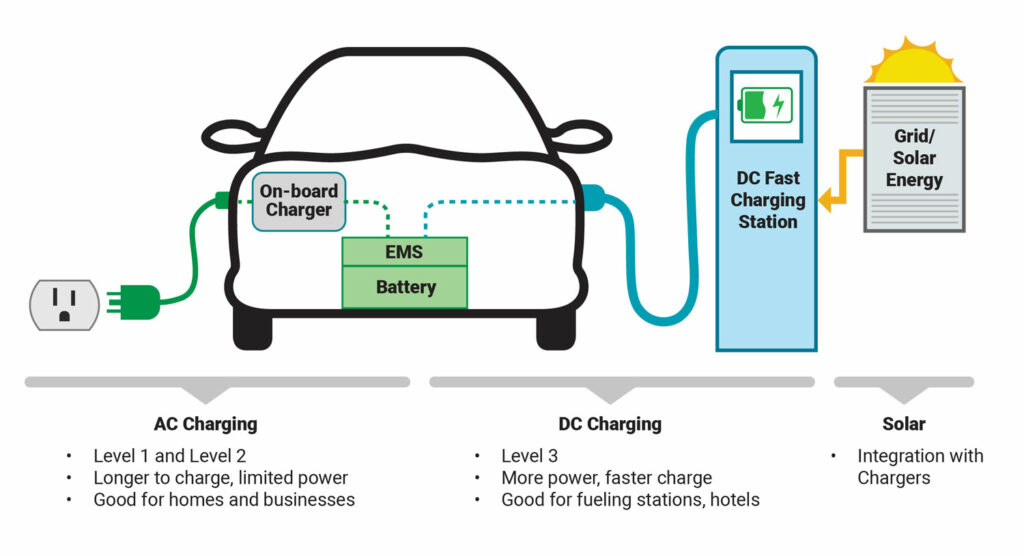Elk Ridge Electric installs electric car chargers in homes and businesses all around the Billings metro area and in our neighboring communities. The demand for electric vehicles (EVs) is exploding. Worldwide demand from 2020-2022 increased 350%. In fact, as many of you probably know, demand is outpacing supply and infrastructure. But that doesn’t mean it’s expected to slow down. In fact, something called the Osborne Effect is at play – consumers will hold off on purchasing a soon-to-be obsolete item (gas powered cars and trucks) and wait for the newer, better version (EVs). Even if the wait is long.

Business or Home Car Charger options
We install all 3 levels of EV charging stations. But before we talk levels, it is helpful to think of charging an EV like water flowing through a pipe. The voltage of the charger is like the water pressure, and the amps the charger delivers is like the water’s volume.
Level 1 Charger
A standard 120-volt household car charging outlet installed in a garage or on the exterior of a home. Level 1 chargers draw 20 amps of electricity and are good for overnight charging times and plugging in hybrid vehicles. The downside? Level 1 chargers only provide 2-3 miles of charging per hour (taking 20+ hours to completely charge an EV).
Level 2 Charger
Requires a 240-volt dedicated electrical circuit to operate. These chargers are significantly faster, charging 10-60 miles per hour of charging. Not only are the volts (water pressure) higher, but also the amps (water volume) it delivers is 30-50. The higher the voltage and amperage, the faster the charging.
Level 3 Charger
DC fast chargers (not AC like Level 1 and 2). They are not installed in homes but found along highways and in urban areas such as outside hotels and at fueling stations. These chargers are capable of 1000 volts and 500 amps, charging in 15-45 minutes.
How much it costs to charge your EV
Charging a car at home will typically add $30 to $60 per month to your utility bill. They may cost more upfront, but they’re cheaper to fuel and maintain than gas-powered vehicles. This of course depends on a lot of factors such as how much of a range your EV has, how often you drive it, and whether your miles are in town (lots of starting and stopping) vs highway or interstate.
Electric Car Charging in Billings Montana
 Batteries are like people. They don’t like temps that are too hot or too cold – anything below 40 degrees or above 115 degrees compromises their peak performance. Not only will the charge rate be slower, but 12% of their range is lost in cold weather (increasing to 41% when the heater is on full blast).
Batteries are like people. They don’t like temps that are too hot or too cold – anything below 40 degrees or above 115 degrees compromises their peak performance. Not only will the charge rate be slower, but 12% of their range is lost in cold weather (increasing to 41% when the heater is on full blast).
Knowing that we have cold weather in Billings, the first thing you can do is buy an electric car with as much range as possible. Forgo the pricey upgrades (seats, cargo room, towing capacity), and put all your money into range. There are now EVs with greater than 350 miles of range – the Lucid Air has 516 miles of range and the Tesla Model S has a range of up to 405 miles.
Secondly, have your car charger installed in the garage. And, turn on the heat while the car is charging (this will give you as much charge as is possible).
Lastly, avoid high speeds and heavy breaking. These add to range loss. Never let your car idle and warm up with the heat on. Also, choose seat warmers over running the heat on high.
Home and Business requirements for an electric car charger
As long as you don’t park on the street, your home or business should be able to accommodate an EV charger. You need a driveway or garage so there is a wall for the charger to be installed on. Chargers typically come with 25 feet of cable, so as long as you can park that close to the charger, you should be in good shape.
If you have a Level 2 charger you will need to consult an electrician to know if your electrical system has the capacity to support your EV charger. Electricians can add circuitry to accommodate the capacity required for Level 2 charging.
With Level 2 chargers, there will need to be room inside the electrical panel for additional breakers as it will need a 50-amp breaker. If not, you may need an electrician to upgrade the panel. And, if your electrical panel is in the basement, or otherwise difficult to access, that electrician may need to do more drilling to run the wire for the EV charger.
If you only have a 100 or 150-amp service, you may need an electrician to upgrade it to a 200-amp service. A 100-amp service (especially) could experience flickering and dimming lights and nuisance tripping of breakers with the higher load of the EV charger.
All this is good to know when calculating the actual expense of investing in an electric vehicle (ideally, before the purchase).
Installing electric car chargers in a condo
If you live in a condo, the board may dictate if the charges would be shared and who would pay for upgrading the electrical panel or service if necessary. It usually comes down to the bylaws and rules established by the complex and therefore is condo specific.
Interested in having an electric car charger installed in your home or business?

Elk Ridge Electric has installed electric car charging stations in homes and businesses all over Billings and the surrounding Montana area. The skilled team of electricians can identify if your home or business is compatible with a EV charger, and if not, what it would take to make it compatible.
If you own an electric vehicle and want the convenience and cost savings of charging at home or at your business, request a free appointment on our request a bid or service form!


